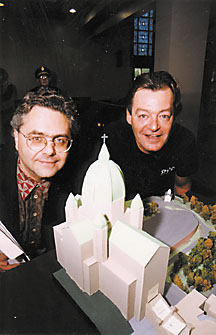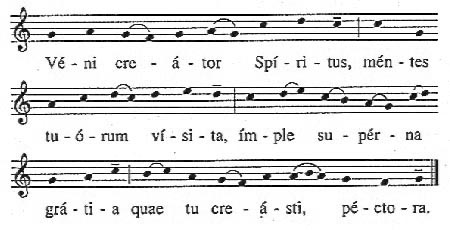THE MILLENNIUM SYMPHONY A Work for the Beginning of Time Part 1: The Musical Challenge by Marc Chénard
/ May 1, 2000
Version française...
 On June 3 at precisely 8:30pm, a peal of 2,000 hand bells will
ring out over the slopes below St. Joseph's Oratory in Montreal,
marking the opening of The Millennium Symphony, a mammoth
outdoor musical happening. For Walter Boudreau, head of the Société
de musique contemporaine du Québec, it will be the most
important musical gathering of his life.
On June 3 at precisely 8:30pm, a peal of 2,000 hand bells will
ring out over the slopes below St. Joseph's Oratory in Montreal,
marking the opening of The Millennium Symphony, a mammoth
outdoor musical happening. For Walter Boudreau, head of the Société
de musique contemporaine du Québec, it will be the most
important musical gathering of his life.
For 90 minutes, fifteen musical groups will participate in
the performance of this magnum opus on the Oratory grounds,
among them the Montreal Symphony Orchestra, the Société
de musique contemporaine du Québec, the band of the Royal
22nd Regiment, and Les Petits Chanteurs du Mont-Royal -- to say
nothing of the Oratory's great organ and carillon, the sirens
of two fire trucks, and, as the crowning touch, 2,000 bell ringers
in the audience. (The logistics of this gigantic undertaking will
be covered in next month's La Scena Musicale.)
The media in general have focussed on this aspect of the performance,
but this is only one side of the coin. The reverse side reveals
what amounts to an enormous musical jigsaw puzzle, collectively
created by a total of 19 composers, each assigned to one of the
participating ensembles. Composer Walter Boudreau is the mastermind
of the work, along with project co-director and close associate,
composer Denys Bouliane. Individual participants include John
Rea and Gilles Tremblay among the older generation, Jean Lesage
and Estelle Lemire among the younger, and composer-performers
such as Anthony Rozankovic and André Duchesne from the
jazz and musique actuelle scenes respectively.
Given the wide range of composers and performers involved,
the inevitable question arises: since there are as many artistic
visions as individuals in this project, how is it possible to
make them all work together?
"We had to invent a code," says Boudreau. "It
would have been unthinkable to get all the composers together
without any prior planning. Rather than impose rigid rules or
tell them how they should compose their respective sections, we
tried from the outset to suggest guidelines to help us find a
common ground."
To do this, Boudreau proposed a Gregorian chant as a main theme
-- "Veni Creator Spiritus." It is heard at the beginning
and end of the work, and is interwoven with the music throughout,
each composer transforming it. The choice of theme is unusual,
Boudreau admits. He has a personal preference for this piece of
music, but was also attracted by its simplicity and the way the
melody line lends itself to various rhythmical and harmonic variations.
(See chart.) Those who listen closely will also hear elusive references
to Mussorgsky's Boris Godunov.
Unusual structure
Boudreau needed an overall structure for the various composers
to work effectively. He and Bouliane had a number of discussions
which resulted in an initial score outline. This was continually
revised as work progressed. There isn't space to do it justice
here, but briefly the structure consists of seven interconnected
movements and their respective timings as follows:
| I |
II |
III |
IV |
V |
VI |
VII |
VIIa |
| Prologue |
Hell |
Purgatory |
Contemplation |
Paradise |
Ascension |
Apotheosis |
Epilogue |
| 4 min |
8 min |
45 min |
5 min |
15 min |
8 min |
4 min |
1 min
|
Note that the third movement takes up half of the symphony's
90 minutes -- not inappropriate when one considers the history
of humanity in all its excesses.
"With this initial structure we were able to prepare a
more detailed blueprint in which all the musical elements were
calculated down to the last second. We put all the data into our
studio computers," Bouliane told us as he scrolled through
the work on screen. "Printing out the file required at least
35 feet of paper!"
The time, or horizontal scheme, is balanced by a vertical axis
involving criteria for the ensembles and the music itself:
1. Order of ensemble performance
2. Melodic material
3. Relative speed of performance
4. "Atmosphere"
5. General dynamics
6. "Spatialization"
7. Statement and restatement of the cantus firmus over
the work's entire length.
Two of these seven criteria need some explaining. The first
establishes the various roles assigned to participating ensembles.
A given group might take the lead and fill the role of soloist,
with or without the assistance of other groups. The entry of a
solo group can be independent (without reference to the music
that precedes it) or dependent (referring to the preceding music).
Groups may, however, perform together on a fairly equal footing,
with one filling a main or subordinate role while a second performs
in the independent or dependent mode described above. In a third
scenario, the tutti instruction indicates that one ensemble
will take the lead while the rest are subordinate, as happens
at the end of the work. And who will take the lead in the symphony's
grande finale? You'll have to be there to find out!
The sixth criterion, "spatialization," describes
how the music will move in space within the performance area.
For example, in the second movement (Hell) the music moves progressively
and in an increasingly erratic manner from the centre toward the
periphery of the area. In the fourth movement (Contemplation),
the music moves initially from the centre to the periphery, then
returns to the centre. The effect is akin to the "surround"
sound much favoured in top-of-the-line stereophonic systems. Boudreau
has promised us a similar experience which he describes in French
by the somewhat whimsical term of "toutpartoutphonie."
The orchestration of the symphony's various elements is almost
complete, and a copyist is now hard at work producing all the
scores for no less than 333 musicians. "The number is pure
coincidence," says SMCQ press attaché Suzanne Samson,
who admits it is surprising all the same, and that "we counted
them several times to make sure, and got the same figure every
time."
[Translated by Jane Brierley]
Next month: The Organizational Challenge
Note: At the time of writing, 1,200 of the 2,000 bells had
been sold. Three models are available. For details contact the
SMCQ at 514 843-9305 or go to the SMCQ website at www.smcq.qc.ca.
The concert will take place June 4 at 8:30pm if cancelled due
to rain the previous evening.
The Veni Creator: Gregorian Chant Goes Latin
 The Veni Creator Spiritus, a liturgical hymn for Pentecost,
is among the best known sacred music of the Christian tradition.
Its origins can be traced back to the ninth century, but it may
have roots in the music of ancient Greece. Following the translation
of the Latin text by Martin Luther, composers such as Bach and
Buxtehude used it in their organ works.
The Veni Creator Spiritus, a liturgical hymn for Pentecost,
is among the best known sacred music of the Christian tradition.
Its origins can be traced back to the ninth century, but it may
have roots in the music of ancient Greece. Following the translation
of the Latin text by Martin Luther, composers such as Bach and
Buxtehude used it in their organ works.
This Gregorian chant is used as the theme of the Millennium
Symphony, and is a form of springboard for the composers involved
in this collective enterprise. Gilles Tremblay, one of the senior
composers working on the project, has decided to use only children's
voices in the ensemble assigned to him - Les Petits Chanteurs
du Mont-Royal. The children will imitate peals of bells in the
third movement and hum folk music as thematic variations in the
fifth movement. These are known in Quebec folklore as "Turlutes."
Pianist Anthony Rozankovic, one of the younger composers involved,
has focussed on the rhythmical aspect for his contribution, inspired
by ethnic music such as the Brazilian samba, in order to provide
a more syncopated approach. "I made this decision fairly
quickly," he says. "I found it all the more interesting
because I had been assigned the band of the Royal 22nd. A military
band is accustomed to playing music in which the straightforward
downbeat is a major element. I decided to get them marching on
the other foot, as it were."
We asked the two composers what they thought of the symphony.
Tremblay sees it as "a great tapestry and a 'popular' work
in the best sense of the word." Rozankovic compares it to
a "'We Are The World' by 19 composers" type of work.
He likes the Gregorian theme. In his view, "It's a melody
that deserves to be better known."
Marc Chénard / J.B.
Version française... | 

